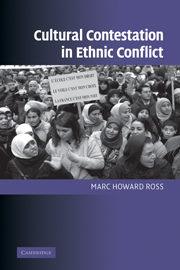Book contents
- Frontmatter
- Contents
- List of figures
- Preface
- 1 Introduction: easy questions and hard answers, what are they fighting about?
- 2 The political psychology of competing narratives
- 3 Narratives and performance: ritual enactment and psychocultural dramas in ethnic conflict
- 4 Loyalist parades in Northern Ireland as recurring psychocultural dramas
- 5 Where is Barcelona? Imagining the nation without a state
- 6 Digging up the past to contest the present: politics and archeology in Jerusalem's Old City
- 7 Dressed to express: Islamic headscarves in French schools
- 8 The politics of memory and memorialization in post-apartheid South Africa
- 9 Enlarging South Africa's symbolic landscape
- 10 Flags, heroes, and statues: inclusive versus exclusive identity markers in the American South
- 11 Culture's central role in ethnic conflict
- References
- Index
- Cambridge Cultural Social Studies
7 - Dressed to express: Islamic headscarves in French schools
Published online by Cambridge University Press: 22 September 2009
- Frontmatter
- Contents
- List of figures
- Preface
- 1 Introduction: easy questions and hard answers, what are they fighting about?
- 2 The political psychology of competing narratives
- 3 Narratives and performance: ritual enactment and psychocultural dramas in ethnic conflict
- 4 Loyalist parades in Northern Ireland as recurring psychocultural dramas
- 5 Where is Barcelona? Imagining the nation without a state
- 6 Digging up the past to contest the present: politics and archeology in Jerusalem's Old City
- 7 Dressed to express: Islamic headscarves in French schools
- 8 The politics of memory and memorialization in post-apartheid South Africa
- 9 Enlarging South Africa's symbolic landscape
- 10 Flags, heroes, and statues: inclusive versus exclusive identity markers in the American South
- 11 Culture's central role in ethnic conflict
- References
- Index
- Cambridge Cultural Social Studies
Summary
Introduction
For two weeks in November 2005, pictures of crowds of young people throwing stones and burning cars in and around Paris and dozens of other French cities flashed across television screens around the world. The spark setting off the violence was an incident in Clichy-sous-Bois, a Paris suburb where two young Muslim boys died in an electrical sub-station while running from the police. In the course of a week more than 8000 cars, mainly in Muslim neighborhoods, were fire-bombed, mainly by young Muslims, and there were over 2500 arrests. Rage over Interior Minister Nicholas Sarkozy's racist comments that the scum would be flushed out and deported, and the government's use of tear gas in a local mosque combined with ongoing alienation over high unemployment, inadequate social services, and feelings of widespread discrimination, making the violence hard to contain. Knowledgeable observers suggested that the outbursts reflected tensions between the primarily Muslim immigrants and their children and the French that had built up over years (Bowen 2006; Cesari 2005; Silverstein and Tetreault 2005; Withol de Wenden 2005).
While there has been ethnic or racial violence at times in France, the most enduring conflict in recent decades has been mainly non-violent; it was a cultural conflict over the right of a small number of Muslim girls to wear headscarves to school (Ross 1993b).
- Type
- Chapter
- Information
- Cultural Contestation in Ethnic Conflict , pp. 191 - 223Publisher: Cambridge University PressPrint publication year: 2007



